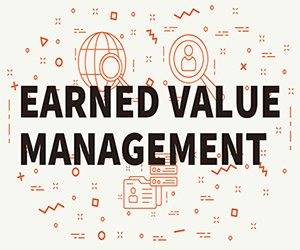
The Budget at Completion (BAC) is a value used in earned value management, a division of project management.
It represents the original project budget. For example, if a project has a budget of $10,000,
- BAC = $10,000
Therefore, there is no other formula or calculation for this metric. The BAC is often compared to the Estimate at Completion (EAC) which represents the forecasted final project budget at the point of analysis (usually right now) based on assumptions of future project performance.
The Earned Value Method
In the earned value method, there are three steps which are performed at regular intervals to ensure the project stays on schedule and budget:
- Data collection: Planned Value (PV), Earned Value (EV), Actual Cost (AC), and Budget at Completion (BAC).
- Current project status: Schedule Variance (SV), Cost Variance (CV), Schedule Performance Index (SPI), and Cost Performance Index (CPI).
- Forecast of future project performance: Variance at Completion (VAC), Estimate to Complete (ETC), Estimate at Completion (EAC), and To Complete Performance Index (TCPI).
The metrics can be reported in a table, like this.
| ID | Name | Start | End | BAC | PV | EV | AC | SV | SPI | CV | CPI | ETC | EAC | VAC | TCPI |
|---|---|---|---|---|---|---|---|---|---|---|---|---|---|---|---|
| 100 | Produce Report | Apr. 1 | Apr. 10 | $10,000 | $3,000 | $2,000 | $4,500 | -$1,000 | 0.67 | -$2,500 | 0.44 | $18,182 | $12,500 | -$2,500 | 1.45 |
As you can see, the Budget at Completion is the project budget, which is part of the first group: Data collection.
Estimating the Budget at Completion
Project estimating techniques are used to determine the BAC during the project planning phase. These estimating techniques are:
- Expert Judgment
If you can find an expert to produce an estimate, or merely to provide advice, it is the best source of information you can get. - Analogous Estimating
This method involves comparing the work to actual costs of a similar project. If you have any differences between the two projects, those must be accounted for using an analysis of what the differences are. For example, we planted five trees for project A, therefore if we need to plant 10 trees for project B, we will estimate twice the cost of project A, but we estimate the trees to be 20% larger therefore we will add 20%. - Parametric Estimating
This method involves determining the cost of a project via unit rates, determined from doing that type of work many times. In the construction industries, average rates are often published in industry guides (although the individual rates are usually top secret!) or project based organizations have average rates for different tasks. The estimator must analyze what is different between their project and the average project. For example, our firm has a cost of $750 per tree, but these trees are 10% smaller than the average therefore we will subtract 10%.
The estimates are usually done on a task level and rolled up into the overall project using a technique called bottom up estimating. If starting from the top and apportioning a larger estimate into individual tasks, it is called top down estimating.
Sample PMP Exam Questions
- A project has an original budget of $150,000, with a CPI of 0.9 and a EAC of $175,000. What is the Budget at Completion (BAC)?
- $15,000
- $165,000
- $150,000
- $175,000
- A Contractor bids $1,250,000 for a development project. Upon commencement of the project, an unknown sewer line is encountered and a request for extra work is requested, for $50,000. The request is approved. After construction is complete, the Contractor’s actual cost (AC) of the work is $1,400,000. What is the Budget at Completion (BAC)?
- $1,400,000
- $1,250,000
- $1,300,000
- $1,450,000
Answers:
- C. The Budget at Completion (BAC) is the original project budget: $150,000.
- B. The Budget at Completion (BAC) is the original project budget: $1,250,000. The EAC is the revised project budget, or $1,400,000.
Budget at Completion Example
 A project to renovate an office has a start date of January 1 and a completion date of February 28. The project budget is $100,000. There are four tasks:
A project to renovate an office has a start date of January 1 and a completion date of February 28. The project budget is $100,000. There are four tasks:
- Demolition
- Build Walls
- Install Carpet
- Paint Walls
At an earned value progress point (say, January 31), the earned value calculations might look like this:
| ID | Name | Start | End | BAC | PV | EV | AC | SV | SPI | CV | CPI | ETC | EAC | VAC | TCPI |
|---|---|---|---|---|---|---|---|---|---|---|---|---|---|---|---|
| 1.0 | Demolition | Jan. 1 | Jan. 10 | $5,000 | $5,000 | $6,000 | $6,500 | $1,000 | 1.2 | -$500 | 0.92 | -$1,065 | $5,435 | -$435 | 0.67 |
| 2.0 | Build Walls | Jan. 11 | Feb. 2 | $45,000 | $40,000 | $36,000 | $38,000 | -$4,000 | 0.9 | -$2,000 | 0.95 | $,9368 | $47,368 | -$2,368 | 1.29 |
| 2.1 | Install Carpet | Feb. 2 | Feb. 15 | $25,000 | $0 | $1,000 | $1,000 | $1,000 | 1.0 | $0 | 1.0 | $24,000 | $25,000 | $0 | 1.0 |
| 2.2 | Paint Walls | Feb. 5 | Feb. 28 | $15,000 | $0 | $0 | $0 | $0 | 1.0 | $0 | 1.0 | $15,000 | $15,000 | $0 | 1.0 |
| TOTAL | $100,000 | $45,000 | $43,000 | $45,500 | -$2,000 | 0.96 | -$2,500 | 0.95 | $59,763 | $105,263 | -$5,263 | 1.05 | |||
Conclusions
- Out of the project budget ($100,000), just under half ($43,000) has been performed.
- Two tasks are ahead of schedule (SV > $0), one task is behind schedule (SV < $0), and one task has not started yet.
- Two tasks are over budget (CV > $0) and two are right on budget or not started yet.
- The expected final project cost is $105,263, which is $5,263 over the project budget of $100,000.
- In order to complete the project on budget, the work needs to be 5% more efficient than the originally planned efficiency level (TCPI = 1.05).
- The task Build Walls is almost complete and is 5% less efficient than planned (CPI = 0.95). In order to finish on budget, the efficiency level of this task needs to be 29% greater than the planned level (TCPI = 1.29).
For more information, please visit our Earned Value Tutorial.






